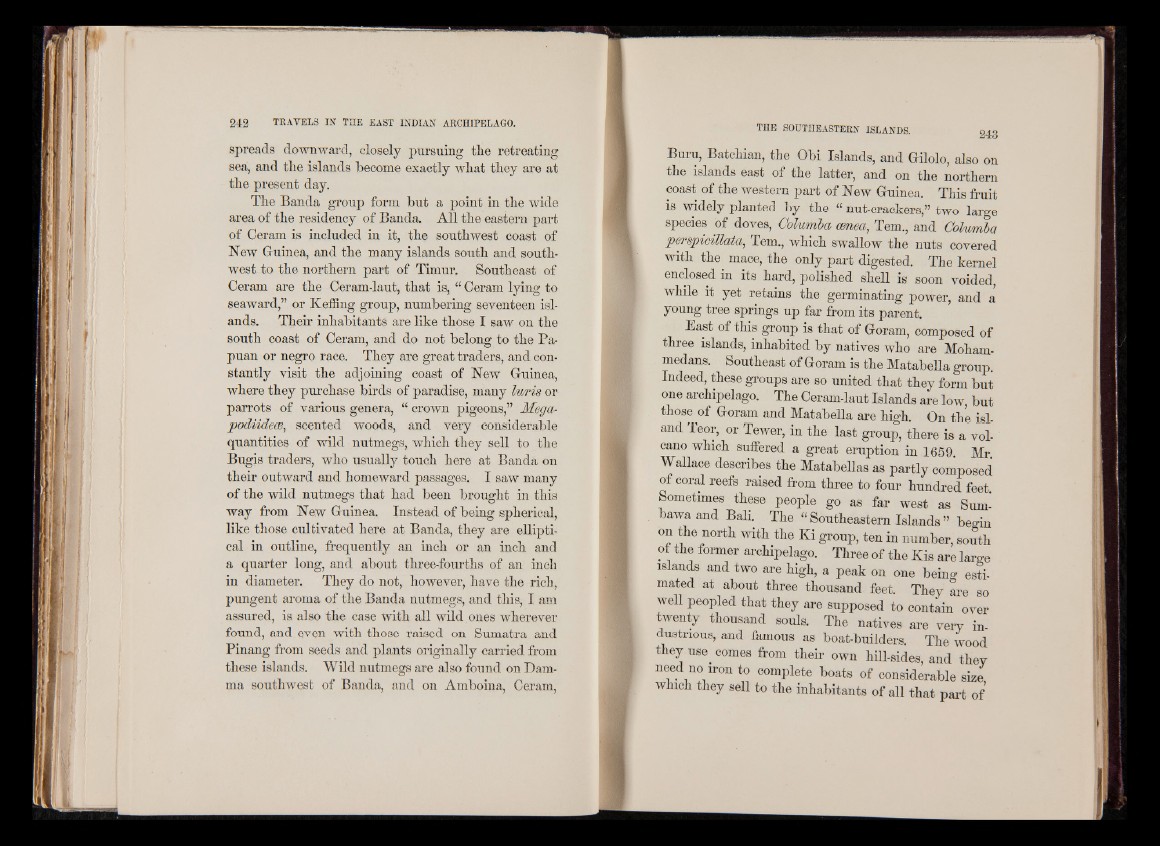
spreads downward, closely pursuing the retreating
sea, and the islands become exactly what they are at
the present day.
The Banda group form but a point in the wide
area of the residency of Banda. All the eastern part
of Ceram is included in it, the southwest coast of
New Guinea, and the many islands south and southwest
to the northern part of Timur. Southeast of
Ceram are the Ceram-laut, that is, “ Ceram lying to
seaward,” or Keffing group, numbering seventeen islands.
Their inhabitants are like those I saw on the
south coast of Ceram, and do not belong to the Papuan
or negro race. They are great traders, and constantly
visit the adjoining coast of New Guinea,
where they purchase birds of paradise, many 1/wris or
parrots of various genera, “ crown pigeons,” Mega-
podiidecB, scented woods, and very considerable
quantities of wild nutmegs, which they sell to the
Bugis traders, who usually touch here at Banda on
their outward and homeward passages. I saw many
of the wild nutmegs that had been brought in this
way from New Guinea. Instead of being spherical,
like those cultivated here at Banda, they are elliptical
in outline, frequently an inch or an inch and
a quarter long, and about three-fourths of an inch
in diameter. They do not, however, have the rich,
pungent aroma of the Banda nutmegs, and this, I am
assured, is also the case with all wild ones wherever
found, and even with those raised on Sumatra and
Pinang from seeds and plants originally carried from
these islands. Wild nutmegs are also found on Dam-
ma southwest of Banda, and on Amboina, Ceram,
Buru, Batchian, the Obi Islands, and Gilolo, also on
the islands east of the latter, and on the northern
coast of the western part of New Guinea. This fruit
is widely planted by the “ nut-crackers,” two large
species of doves, Columba cenea, Tern., and Columba
perspicillata, Tern., which swallow the nuts covered
with the mace, the only part digested. The kernel
enclosed in its hard, polished shell is soon voided,
while it yet retains the germinating power, and a
young tree springs up far from its parent.
East of this group is that of Goram, composed of
three islands, inhabited by natives who are Mohammedans.
Southeast of Goram is the Matabella group.
Indeed, these groups are so united that they form but
one archipelago. The Ceram-laut Islands are low, but
those of Goram and Matabella are high. On the island
Teor, or Tewer, in the last group, there is a volcano
which suffered a great eruption in 1659. Mr.
Wallace describes the Matabellas as partly composed
of coral reefs raised from three to four hundred feet.
Sometimes these people go as far west as Sum-
bawa and Bali. The “ Southeastern Islands ” begin
„n0rtl1 tlie Ki grouP> ten in number, south
of the former archipelago. Three of the Kis are large
islands and two are high, a peak on one being estimated
at about three thousand feet. They are so
well peopled that they are supposed to contain over
twenty thousand souls. The natives are veiy in-
dustnous, and famous as boat-builders. The wood
they use< comes from their own hill-sides, and they
need no iron to complete boats of considerable size
which they sell to the inhabitants of all that part of